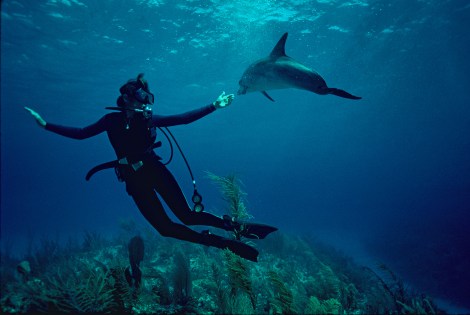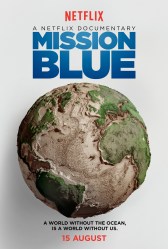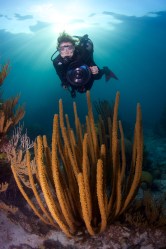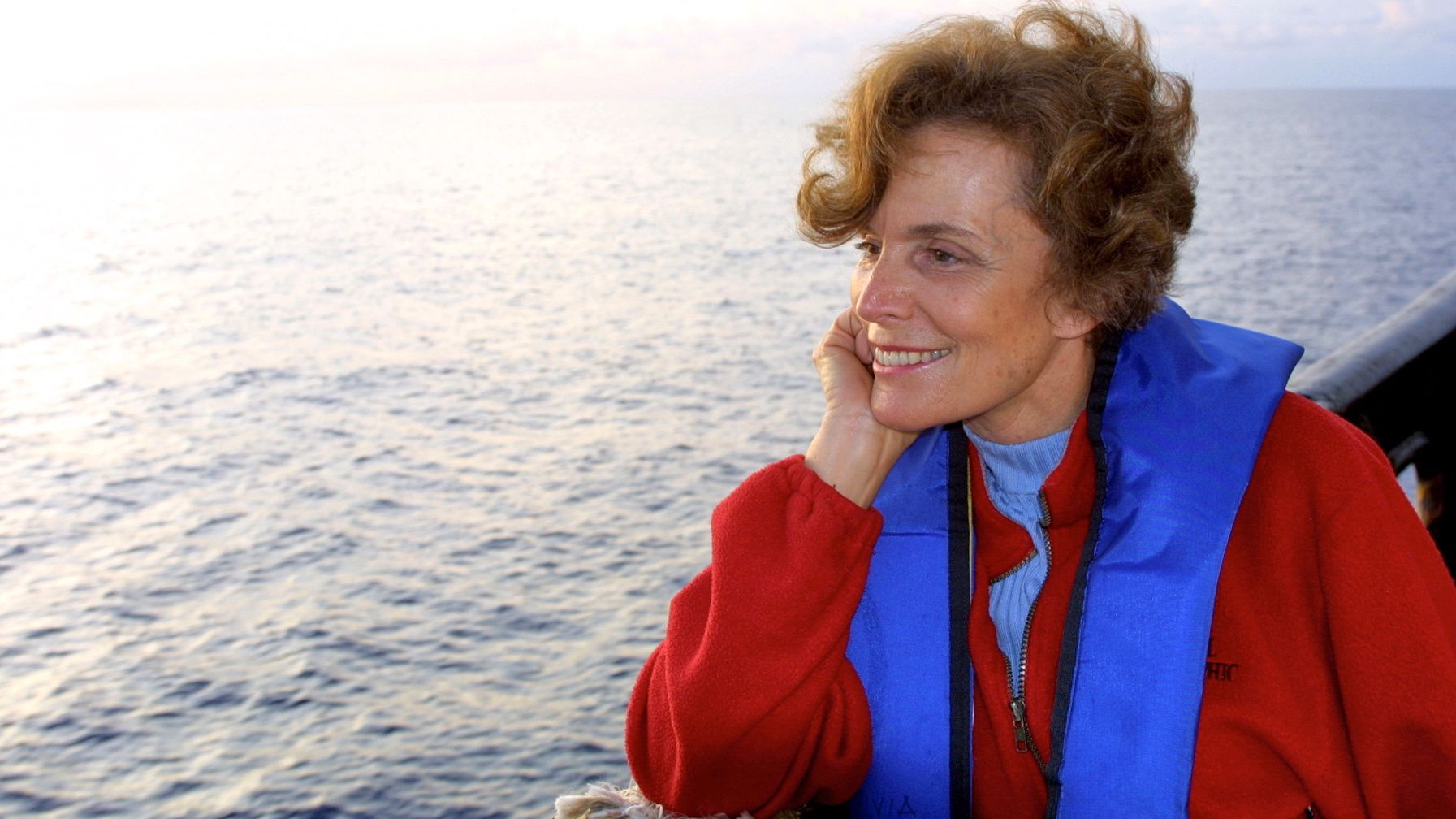Forget what you’ve been told. The main problem the ocean faces is not acidification. It’s not overfishing. It’s not dead zones, dying reefs, or great big patches of garbage.
OK, those are all pretty big issues. But there might be an even bigger one: The average person doesn’t care about them. Bring up the fact that the ocean sucks up about 22 million tons of CO2 a day at a backyard BBQ and chances are you’ll hear a big, resounding “meh.” As shown in Netflix’s splashy new documentary Mission Blue, which premieres Aug. 15, marine biologist Sylvia Earle has spent a lifetime trying to turn meh into action.
You’d be hard pressed to find someone who knows the ocean as well as Earle does. Now 78, she’s spent decades exploring and studying oceans all over the world. She’s designed submarines, held depth records, was the first woman to serve as chief scientist at the National Oceanic and Atmospheric Administration, and she’s now spent what adds up to at least 292 full days underwater (and she’s still going strong). Basically, she’s an all around badass — though she might not call herself that.
I first learned about Earle during my sophomore year of college, when I got to sail across the Pacific Ocean with SEA Semester, an undergrad program for oceanography buffs. Having grown up on California’s coast, I’d always felt a strong affection for the ocean (or at least a weird penchant for perusing tidepools in order to poke at gelatinous blobs). But, somewhere between trying not to throw up on myself while staring at phytoplankton through a microscope and nursing the infected tattoo I got in the Marquesas (YOLO?), I came to understand the difference between looking at the ocean in terms of what I saw from the shore, and seeing it. From the shore I understood the ocean as pretty scenery; over those five weeks at sea, I came to see it as a three-dimensional, complex being that you just become obsessed with knowing and grasping. In other words, I fell in love with it.

Earle diving in a scene from Mission Blue
So, when I heard and read about Earle, she obviously became an instant hero. “Now that’s the kind of lady I’d like to be,” I thought. She knows what she loves and is fearless in standing up for it.
I’m psyched to have gotten the chance to talk with Earle and Robert Nixon, one of the directors of Mission Blue. Our conversation touched on connecting people to the ocean in the modern day, how to boldly follow your calling, and the glimmers of hope Earle finds coming out of a deep, dark place. Here’s an edited and condensed version of what Earle and Nixon had to say:
Q. Do you ever get frustrated at trying to make people care about something that’s still so vague and distant to so many of us?
A. Earle: I have struggled with this for most of my professional life, trying to get others to see what I have had the privilege of seeing. I think I’m encouraged with breakthroughs such as the development of Google Earth. Holding the world in your hands the way that you can with Google, it’s different than just looking at a flat map. And with the ocean in Google Earth, you can dive in and see what’s beneath the surface without getting wet. You can see things that our predecessors could not imagine. Kids today have access to this kind of visual insight.
You look at all the other creatures on Earth – and there are some that travel widely, like whales and dolphins and birds, and see a lot of the planet, more than many people do. But we can visualize the whole thing. And we’re the only ones in human history to be able to do this: It isn’t just that we’re humans, it’s because we’re humans in the 21st century, armed with unprecedented insight and opportunity to take all this knowledge that has been accumulating through all of previous time, and use it to our advantage in figuring out how do we behave ourselves so we don’t destroy the very systems that are keeping us alive.

Netflix
Nixon: As a filmmaker, I’ve done many films on and under the ocean, but fully portraying how the ocean has changed is such a challenge, as Carl Safina says in the film, because the ocean still looks the same, the waves still look the same on the surface. The main challenge that [Mission Blue co-director Fisher Stevens] and I faced was how to engage the public. Because we didn’t want to preach to the converted, we wanted to show people that didn’t know. And that’s why Sylvia is such a precious resource herself, having been a witness to the change.
My interest has always been in the people side of things. Maybe I just don’t have the patience to like to film wildlife, but I’m much more interested in the human connection. It’s humans that got us into this mess, it’s humans that are going to get us out. Because there are people like Dr. Sylvia Earle who are out in front, it’s my goal in life to shine a light on them and give them a microphone.
Q. From the outside, it seems as if you’ve been able to accomplish so much of what you’ve done because it didn’t occur to you to hold yourself back. Were there any moments in which you weren’t sure that you were making the right choices?
A. Earle: It’s never really been a choice. From as long as I can remember, I’ve been driven to observe plants and animals and try to understand them. I didn’t know what it meant to be a biologist or an ecologist or whatever it is that I morphed into. I suppose it was just unconsciously making the choice to take whatever classes I could about the things I love. And I had the freedom to do that with parents who didn’t insist that I become a secretary or insist that I do something practical, even though I was warned that I probably could not make a living as a biologist. But they let me follow my heart. So I did. I am, still.
And yes, it’s still hard to make a living as a biologist. But the flip side is, you know, life is more important than making a living, I suppose. At least that’s the way I rationalized it.

Netflix
Q. Robert, what parts of Sylvia’s character did you most want to bring out in Mission Blue?
A. Nixon: How brave she is and what a groundbreaker she’s always been in her life. The film talks a lot about her as a trailblazer as a woman pushing through these areas. But also just as a human being blazing the way to show us that we’re all one in the systems of the natural world. She was always ready to dive in.
Earle: But, you know, just look at a little kid. A little kid is absolutely fearless. I’ve seen my grandson at the age of two walk right in to the ocean. Shoes on, and no hesitation. Scientists are like little kids. Open minds, asking questions, curious about everything. Everything is a sense of wonder. And you want to show others, “Look, mom, there’s a beetle!” Not afraid, unless you teach them to be afraid. I guess scientists are like little kids who don’t show the fear you learn over time.
I don’t really think of some of the things I’ve done as brave or courageous, I just really want to know what’s going on! And it’s “let’s go, let’s jump in and find out.” I don’t think I’m so special. If I can do these things anybody can. I’m not superwoman, by any means. I’m just a little kid who forgot to grow up.
Nixon: And that’s really just been so much fun. We’ve had so much fun on this trip – it’s been exhausting trying to keep up with Sylvia. But it’s been quite an experience seeing the planet through her eyes.

Netflix
Q. A lot of the film documents how the oceans have changed over Dr. Earle’s life. What were some of the biggest changes that you encountered while making the film?
A. Nixon: It was really powerful when we went to St. John, the site of the Tektite habitat where [Dr. Earle] lived underwater, and to go there and see that reef devastated. And then to go to the Coral Sea … that expedition was supposed to allow our cameraman to film the most beautiful untouched habitat.
Earle: We went there to find paradise, and we found paradise lost.
Nixon: It was just devastating to see that.
But then, going to Cabo Pulmo [which has been protected as of 1995] – that was thrilling. To dive in there and see how the world has rebounded.
Earle: It had rebounded, through protection. Reasons for hope – hope spots.
Q. Yeah! Mission Blue ends with your plan for a network of marine protected areas, which you call hope spots. How optimistic are you feeling that we’ll be able to make that into a reality?
A. Earle: I’m greatly encouraged. Actually, just these last few months there’s been significant progress. Like President Obama announcing his intent to establish an area bigger than all the national parks put together, which he brought up at the state department ocean conference in June.
And other nations are stepping up right now. About two years ago the U.K. protected the waters surrounding the Chagos Archipelago in the Indian Ocean. In the Pacific we’re seeing a lot of island nations realize they have jurisdiction over a lot of ocean – a little bit of land, but a lot of ocean. Just in the last few weeks, the president of Palau has reaffirmed what he said at a United Nations meeting in New York, that he intends to close all of his country’s exclusive economic zones to the industrial fishing that has taken a big bite out of the sharks, the tunas, and other ocean wildlife. So protecting our oceans is an idea that’s catching on. And I’m optimistic that once people see that it really works – like in Cabo Pulmo – it’s really going to begin to catch fire.
Mission Blue will be available on Netflix on Aug. 15. Watch the trailer:



